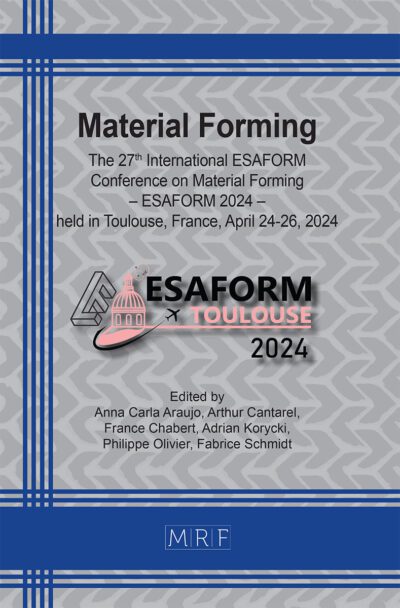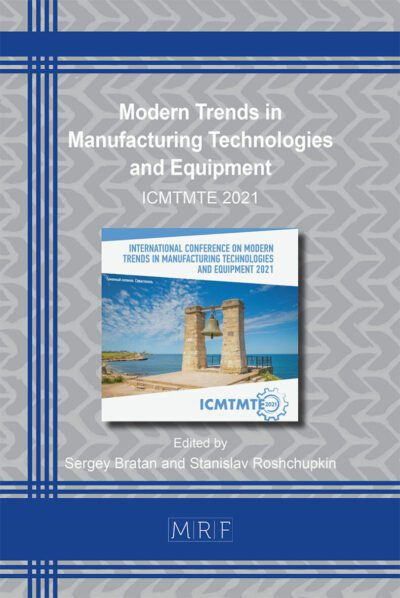Effect of manufacturing process on mechanical properties of polyetheretherketone (PEEK) cranial implants produced by single-point incremental forming (SPIF)
Elizabeth MAMROS, Ihab RAGAI, Brian YOUNG
Abstract. Polyetheretherketone (PEEK) is one of the most commonly used materials for cranioplasty due to its biocompatibility, relatively high strength, and light weight. Cranial implants manufactured from PEEK sheets using the same manufacturing process, e.g., single point incremental forming (SPIF), will have differing part properties based on the selected polymer forming process. Three fabrication methods for PEEK sheets were investigated: extrusion, modified hot pressing, and injection molding. Material characterization specimens were extracted for tensile, impact, and differential scanning calorimetry (DSC) experiments. The PEEK sheets were also subjected to formability tests at room temperature using SPIF. Slight differences in ultimate tensile strength and impact strength were observed, while formability was largely unaffected by the polymer manufacturing process. Therefore, the polymer manufacturing process can be selected based on equipment and material availability to speed up the custom cranial implant fabrication without impacting the ultimate material properties. This is a critical step in increasing accessibility for patients and exploring other manufacturing processes capable of producing custom cranial implants, e.g., SPIF.
Keywords
PEEK, Cranioplasty, Craniectomy, Incremental Forming, Formability, Histocompatibility
Published online 5/7/2025, 10 pages
Copyright © 2025 by the author(s)
Published under license by Materials Research Forum LLC., Millersville PA, USA
Citation: Elizabeth MAMROS, Ihab RAGAI, Brian YOUNG, Effect of manufacturing process on mechanical properties of polyetheretherketone (PEEK) cranial implants produced by single-point incremental forming (SPIF), Materials Research Proceedings, Vol. 54, pp 1191-1200, 2025
DOI: https://doi.org/10.21741/9781644903599-130
The article was published as article 130 of the book Material Forming
![]() Content from this work may be used under the terms of the Creative Commons Attribution 3.0 license. Any further distribution of this work must maintain attribution to the author(s) and the title of the work, journal citation and DOI.
Content from this work may be used under the terms of the Creative Commons Attribution 3.0 license. Any further distribution of this work must maintain attribution to the author(s) and the title of the work, journal citation and DOI.
References
[1] Zhang, J., Tian, W., Chen, J., Yu, J., Zhang, J., and Chen, J., 2019, “The Application of Polyetheretherketone (PEEK) Implants in Cranioplasty,” Brain Research Bulletin, 153, pp. 143–149. https://doi.org/10.1016/j.brainresbull.2019.08.010
[2] Cheng, C.-H., Lee, H.-C., Chen, C.-C., Cho, D.-Y., and Lin, H.-L., 2014, “Cryopreservation versus Subcutaneous Preservation of Autologous Bone Flaps for Cranioplasty: Comparison of the Surgical Site Infection and Bone Resorption Rates,” Clinical Neurology and Neurosurgery, 124, pp. 85–89. https://doi.org/10.1016/j.clineuro.2014.06.029
[3] Matsuno, A., Tanaka, H., Iwamuro, H., Takanashi, S., Miyawaki, S., Nakashima, M., Nakaguchi, H., and Nagashima, T., 2006, “Analyses of the Factors Influencing Bone Graft Infection after Delayed Cranioplasty,” Acta Neurochir (Wien), 148(5), pp. 535–540. https://doi.org/10.1007/s00701-006-0740-6
[4] Lethaus, B., Safi, Y., ter Laak-Poort, M., Kloss-Brandstätter, A., Banki, F., Robbenmenke, C., Steinseifer, U., and Kessler, P., 2012, “Cranioplasty with Customized Titanium and PEEK Implants in a Mechanical Stress Model,” Journal of Neurotrauma, 29(6), pp. 1077–1083. https://doi.org/10.1089/neu.2011.1794
[5] Heron, M. J., Zhu, K. J., Yusuf, C. T., Njoroge, M. W., Bhagwat, A. M., Galaria, A. I., Lopez, C. D., and Yang, R., 2023, “Three-Dimensional Printing for Craniomaxillofacial Surgery: A Systematic Review and Meta-Analysis of Applications and Logistical Outcomes,” FACE, 4(2), pp. 160–170. https://doi.org/10.1177/27325016231156385
[6] Ambrogio, G., De Napoli, L., Filice, L., Gagliardi, F., and Muzzupappa, M., 2005, “Application of Incremental Forming Process for High Customised Medical Product Manufacturing,” Journal of Materials Processing Technology, 162–163, pp. 156–162. https://doi.org/10.1016/j.jmatprotec.2005.02.148
[7] Duflou, J., Behera, A., Vanhove, H., and Bertol, L., 2013, “Manufacture of Accurate Titanium Cranio-Facial Implants with High Forming Angle Using Single Point Incremental Forming,” Key Engineering Materials, 549, pp. 223–230. https://doi.org/10.4028/www.scientific.net/KEM.549.223
[8] Castelan, J., Fritzen, D., Daleffe, A., and Schaeffer, L., 2015, “Design of Custom-Made Cranial Implant using 3D Technologies and Incremental Sheet Forming Process,” Proceedings of the 6th International Conference on Mechanics and Materials in Design, pp. 521-526.
[9] Lu, B., Ou, H., Shi, S. Q., Long, H., and Chen, J., 2016, “Titanium Based Cranial Reconstruction Using Incremental Sheet Forming,” Int J Mater Form, 9(3), pp. 361–370. https://doi.org/10.1007/s12289-014-1205-8
[10] Rosa-Sainz, A., García-Romeu, M. L., Ferrer, I., Silva, M. B., and Centeno, G., 2023, “On the Effective Peek Application for Customized Cranio-Maxillofacial Prostheses: An Experimental Formability Analysis,” Journal of Manufacturing Processes, 86, pp. 66–84. https://doi.org/10.1016/j.jmapro.2022.12.044
[11] Rosa-Sainz, A., Ferrer, I., Garcia-Romeu, M. L., Silva, M. B., and Báez, G. C., 2023, “On the Manufacturing of a Cranial PEEK Implant Using SPIF,” Key Engineering Materials, 957, pp. 61–70. https://doi.org/10.4028/p-M58CpV
[12] Gatea, S., and Ou, H., 2024, “Experimental Testing and Numerical Modelling of Ductile Fracture of PEEK in Incremental Sheet Forming Process,” Materials Research Proceedings, Materials Research Forum LLC, Toulouse, pp. 1596–1605. https://doi.org/10.21741/9781644903131-177
[13] Zhu, H., Ou, H., and Popov, A., 2020, “Incremental Sheet Forming of Thermoplastics: A Review,” The International Journal of Advanced Manufacturing Technology, 111(1), pp. 565–587. https://doi.org/10.1007/s00170-020-06056-5
[14] Chen, L., Chen, F., Gatea, S., and Ou, H., 2022, “PEEK Based Cranial Reconstruction Using Thermal Assisted Incremental Sheet Forming,” Proceedings of the Institution of Mechanical Engineers, Part B: Journal of Engineering Manufacture, 236(6–7), pp. 997–1004. https://doi.org/10.1177/09544054211045904
[15] https://www.boedeker.com/Product/PEEK-Virgin-Natural. [Accessed: 30-Dec-2024]
[16] ASTM International, 2022, “Standard Test Method for Tensile Properties of Plastics.” https://doi.org/10.1520/D0638-22
[17] ASTM International, 2023, “Standard Test Methods for Determining the Izod Pendulum Impact Resistance of Plastics.” https://doi.org/10.1520/D0256-23
[18] ASTM International, 2021, “Standard Test Method for Transition Temperatures and Enthalpies of Fusion and Crystallization of Polymers by Differential Scanning Calorimetry.” https://doi.org/10.1520/D3418-21
[19] Upcraft, C., Diefenderfer, R., Vanderwiel, C., and Ragai, I., 2023, “Toward Better Formability of Polymeric Materials in Single Point Incremental Forming: Effect of Process Parameters,” Proceedings of the ASME 2023 International Mechanical Engineering Congress and Exposition. Volume 3: Advanced Manufacturing, p.11. https://doi.org/10.1115/IMECE2023-112000
[20] Stryker, “PEEK Customized Implant.” [Online]. Available: https://cmf.stryker.com/products/peek-customized-implant. [Accessed: 30-Dec-2024]













